|
Siddhartha
The members of the
Shakya clan
lived on the banks of the
Rohini river that ran through the southern foothills of the
Himalayas. Their king,
Suddhodana
Gautama,
established its capital in Kapilavastu
where he had a great palace built. He ruled with wisdom and won the support
of his subjects. The queen,
Maya or
Maha Maya
(fig.), was the daughter of the uncle of Suddhodana, who reigned as a king over
a neighbouring district of the same clan.
For twenty
years Maya and Suddhodana remained childless, until one night Maya had a strange
dream in which a
white elephant entered the right hand side of her womb, and she became pregnant. According
to tradition Maya returned to her parental home to give birth and stopped in the
garden of
Lumbini to rest. She was surrounded
by
Ashoka blossoms and when she reached out to
pick a flower, the prince was born. The tradition has it that this event
occurred on the eight day of the month of April, in 623 BC. The newborn was named
Siddharta.

In the royal palace the joy was
soon replaced by sorrow, for some days after the birth of the prince,
Maya
suddenly died. Her younger sister
Maha Prajapati
was appointed foster mother of the child and raised him with love and care.
A hermit with the name
Asita, who lived in the mountains, not far away, noticed a strange radiation around the
palace. Interpreting this as a good omen he set off to investigate and soon found
the child in the palace. He immediately recognised the child to be a
mahapurusha and predicted that if
the child was to grow up in the palace he would become a great king who would
conquer the world, but if he were to abandon his life at the court and
turn to a religious life, he would become a
buddha.

Other texts tell the story of the
reusi
(fig.)
Kalewin
who paid homage to the
newborn prince who then performed his first miracle by placing himself on the
turban of the sage. On the fifth day after the birth, King Suddhodana invited eight
brahmin priests to predict the
future for the prince.
Seven of them confirmed he possessed the favourable signs of a monarch or a buddha,
depending on whether he would aim for a secular or religious life. The
eighth Brahmin affirmed that if he turned his back on a worldly life, he
would attain
Enlightenment.

At first the king was very pleased with
this prediction, but later, he started to worry about the possibility
that his only successor to the throne might leave him. Because of this the king
made every effort to please the prince and tried to spoil him with all kinds of
luxuries but within the palace walls. At the age of seventeen the prince
started his training in royal and martial arts but his thoughts kept drifting off. One day in spring,
Siddhartha left the palace accompanied
by his father and saw a bird that picked a worm from a freshly ploughed field. He wondered why living creatures had to kill each other. The prince
who lost his own mother shortly after birth was deeply impressed by the tragedy
of these small creatures. This thought and the spiritual wound it created
deepened more each day.
The king became increasingly more
concerned for Siddhartha and when he was nineteen years old arranged a
marriage with princess
Yashodhara.
She was the daughter of Suprabuddha, prince of Devadaha castle and a brother of
the deceased Queen Maya. After Siddhartha had passed several tests, including
the lifting of a heavy bow, he won the hand of the princess. At the age of
twenty nine they had a son, who they called
Rahula. Siddhartha then decided to bid farewell to his princely life
and fled the palace accompanied only by his servant
Chandaka
(fig.) and his horse
Kanthaka.

Several times the devil tempted
Siddhartha urging him to return to the palace promising him the whole world,
but he refused. He then shaved bald and departed southward as a mendicant monk,
first visiting the hermit
Bhagava, whose ascetics he observed, and afterwards travelled on to
Arada Kalapa and
Udraka Ramaputra to study their methods
of meditation, in order to attain Enlightenment. When he didn't see any
salvation in this either, he went on to the land of Magadha, where he started an
ascetic life on the banks of the Nairanjana (Neranjara) river in the Uruvilva forest.
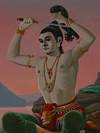
He led an ascetic existence for six years in the presence of five disciples but
was unable to reach his goal. He then decided to abandon this path. Emaciated from ascetic fasting,
he took a bath in the nearby river, where he
accepted a bowl of milk from a village girl named Sujata. Amazed and disappointed
about this the
panjawakkie
left him, though they had initially followed him everywhere.
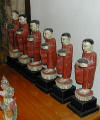
Having had his meal he put the bowl into the river Nairanjana, thinking if he
was to gain Enlightenment, then may that bowl go against the current, i.e. to
float upstream, which we are told came to be accomplished and which is often
explained to symbolically signify that the Buddha's teaching went against all
the teachings of his day.
_small.jpg)
Having wandered around as a mendicant
monk and living the life of an ascetic, in which he couldn't find
salvation, he decided to continue to meditate until he attained Enlightenment. This finally happened after a triumph over the
temptations of
Mara and thus
Siddhartha became a buddha in 588 BC, at the age of thirty five.
回
_small.jpg)
Buddhism
Buddhism
originated as a philosophy in 543 BC in North India and is based on the life of
Siddharta
Gautama, an
Indian prince, whose father
Suddhodana
ruled over the kingdom of the
Shakyas
in
present-day Nepal. In
iconography the long earlobes of the Buddha,
stretched from wearing heavy gold earrings, are proof of his noble descent.
Buddhism
emphasizes compassion for all living
creatures, non-attachment, and release from all suffering by attaining
Enlightenment
which can be gained by following the
Four Noble Truths and the
Eightfold
Path. After the
Buddha's death, two schools gradually
emerged, namely
Mahayana
and
Theravada
or
Hinayana Buddhism.
In Thailand the Theravada form is practiced.
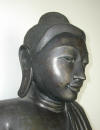
Legend
tells of Siddharta who, whilst meditating under the ‘Tree of Knowledge’, was
constantly disturbed by the diversions of
Mara,
the personification of evil, with the intention to distract him and prevent
him discovering the Four Noble Truths. Siddharta, who had vowed not to
leave the spot under the
bodhi tree
(fig.)
before he found true understanding, suppressed evil and by touching
the earth called upon nature to bear witness to his determination.

In
iconography this event is depicted by Buddha images having the right hand on the knee and the finger tips pointing to
the ground. The left hand rests on the lap
with the palm up. This hand position or
mudra is called
bhumisparsa (fig.) and literally means
‘touching the earth’ and symbolizes ‘the suppression of
evil’. The same mudra in Thailand is called
Maravijaya,
‘victory over Mara’. Siddharta
attained Enlightenment after 49 days of
extreme meditation, at the age of thirty five. Since then he has been known to the
world as Buddha, the Enlightened One, the Awakened One,
Shakyamuni or
Tatakot.
Because his Enlightenment happened under a fig tree on the banks of the Neranjara river
near
Bodh Gaya,
the scientific name of the tree became
Ficus religiosa,
holy fig tree.
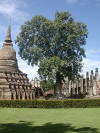
After attaining
Enlightenment the Buddha moved on to
Mrigadava in Varanasi
where the
panjawakkie
stayed. There he preached to them and proclaimed his teachings for the very first
time. They became his first disciples and he set in motion the
Wheel of Law.
He then went on to convert his friend King Bimbisara and criss-crossed the
country begging for food for the next 45 years teaching his
doctrine convincing others of his way of life.

At the age of 80, on
his way from Rajagriha to Shravasti the Buddha became ill at a place called Vaisali where he predicted his
parinirvana, his final transition to
nirvana. He continued on to Pava where he became
seriously ill after eating food offered to him by the blacksmith
Chunda.
In spite of severe pain and weakness he eventually reached the woods that border
Kusinagara
and lay down between two
sala
trees. The Buddha taught his disciples to the very last moment.
He passed away
in 543 BC,
on the exact same day as he was born, and on the same day as he reached
Enlightenment.
_small.jpg)
The cremation of the
body of the Buddha was conducted by
Ananda, one of his favourite followers. Seven
neighbouring rulers as well as King Ajatasatru demanded that his relics were divided
amongst them. The residents of
Kusinagara initially refused this and it almost led to a war. Through the advice
and intervention of a wise man, named Drona, calamity was averted and the
relics were divided between the eight countries. The ashes of the funeral pyre
and an earthen jar with relics were given to two more rulers hence ten
chedi were built to commemorate the Buddha and
house his ashes.
回
Thai Buddhism
Originally the Thai were an
animist
people
but during the reign of King
Ramkamhaeng
(1279-1298) the Great (fig.),
Theravada
Buddhism, the religion that originated in
India
and was introduced to Thailand by Indian missionaries and monks
from Sri Lanka, was adopted as the official State religion.
This religion was however know earlier especially through the campaigns of the
Indian emperor
Ashoka
who sent Buddhist
missionaries to several parts of Asia and Southeast Asia as early as the 3rd
century. The
religion was influenced by aspects from
Brahmanism
and
Hinduism
from which it is derived and which was known in the period of the mighty
Khmer
empire.
Buddhism
has
upheld
well
during the sometimes turbulent chapters of Thai history. It was accepted as the state religion during the
Sukhothai period
and today
around
95% of
the Thai population is Therevada
Buddhist,
making
Thailand the
largest
Therevada Buddhist
country
in the world.
Therevada means
‘teachings of the elders’
and focuses on the
Buddha
and his
teachings
making
this form
of Buddhism
the
closest to the original
teachings, although it is influenced by other religions.
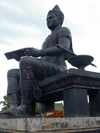
In
Thailand Buddhism is supervised by The
Sangha,
a
board of senior monks. They keep
a close watch on the correct
teaching of tradition and the
transmission of the ancient
Pali
texts,
as well as on the order of monks that need to submit to the
pahtimohk,
the 227 rules of conduct on
monastic discipline as described in the Vinaya Pitaka or
Vinay Pidok. In the
seventies
some
neo-Buddhist
movements and
sects emerged, like the Santi Asok(e) and the
Dhammakaya, but
they gained only a limited following and the Santi Asok(e) was
even placed outside the Sangha
because of its dogmatic
interpretation of tradition.
_small.jpg)
An animist
dimension of
Buddhism
is the superstitious belief in
amulets
and talisman.
This belief is often stimulated by obsession, fear, syncretism and commercial
aspects. Some
venerated monks, the
Phra saksit,
are believed to possess special spiritual powers (saksit) and
amulets blessed by them are used as protection against evil and bad luck. Officially
the Sangha forbids the distribution of amulets since this is in
defiance of the Buddhist doctrine which states that transmission of saksit on
amulets equates to the display of transcendent skills. Many monks, though do not
take this prohibition very seriously thus feeding the superstitions of the
people.
On the sidewalk around
Wat
Mahathat
opposite
Sanam
Luang in
Bangkok, a lively trade in amulets flourishes, usually
with small images of the Buddha and of venerated monks, the
Luang Pho.

One also
encounters
talisman, bringers of fortune. Popular with some Thai males is a phallus carved
from wood and worn around the waist. This amulet, the
pladkik, symbolises the Hindu god
Shiva
and is supposed
to avert
bad luck and attract good fortune. Shiva is
Sanskrit
for ‘luck’. Related to Shiva and the phallus symbol is the
linga,
in Thai called
Siwaleung.
A
symbol
of protection
which is allowed by the Sangha is a thin white string made of cotton, a piece of
thread blessed by monks called
sai sin (fig.)
and which protects against all kinds of evil. It is usually worn
around the wrist but is also used in several kinds of rite, such as cremations,
with weddings in the form of a
mongkon,
in a ceremony called
mongkonlasut.
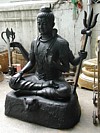
A
semi Buddhist belief with roots in animism
is the
many small to large
sahn phra phum (fig.),
spirit
houses placed in front of buildings where it is believed the
‘protecting spirit of the land’ will dwell. As soon as a new home
is occupied these miniature temples are placed in front of the house so that the
phra phum chao tih, the
spirit that lived on the land, before the building was constructed, can move
back in. To please the spirit regular offerings are made and the spirit houses start looking like small altars. Sometimes a
jawed
is placed inside.
回
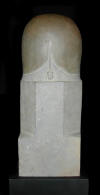
Buddha Images
Buddha images are images of the
historical Buddha or
Siddhartha
Gautama after his
Enlightenment. Any image of
the Buddha is subject to strict
significant
iconographic
rules,
requiring to show the
lakshana
or physical characteristics of a
buddha or great man, especially the 32 major marks described in Buddhist literature,
from which the predestination of a buddha may be recognized at birth. These
include an
ushnisha
(fig.),
sometimes a flame,
a lotus bud (fig.) or halo
(fig.), long fingers and full shoulders, long
earlobes, curled hair, etc.
Tradition later added several
more characteristics such as an
urna or
buddha eye (fig.) and 108 signs
on the foot soles (fig.). The position of the
hands, in Sanskrit called
mudra's
(fig.),
as well as certain poses or
iryapatha (fig.),
are used to relate to certain episodes in the Buddha's life. Different
interpretations led to minor deviations on some
characteristics and usually
indicate a different origin, style or period. Buddha images can not be
sold or bought, they are literally ‘rented’ or ‘rented out’.
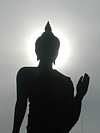
Many Buddhists
also believe that every Buddha image possesses a
fraction of energy of the Enlightened One.
The more images that are gathered together (fig.),
as in
Wat Phra Thamma Kaay, or the bigger the image,
as in
Wat Phra Chetuphon, the more
energy will be radiated. That is why very large images are made or many
smaller images are placed next to each other.
The inner walls of Chinese temples
are often decorated with hundreds, if not thousands of small Buddha images (fig.).
It is said that they represent the words spoken by the Buddha. In Thai phra phutta roop.In Thai they are
called phra phutta roop.
回

Totsachat
In Thai tradition the last ten
incarnations of the Buddha are the most important and are called
Totsachat.
They are often found depicted on murals and are part of the
Jataka,
a word from
Sanskrit-Pali,
in Thai known as
chadok
that represent one of the 550 incarnations that every
soul has to take before he can be born as a
buddha.
Generally it stands for the 547 life stories of the
Buddha, but in Burma three more were added for reasons of
symmetry for mural painting.
The
jataka of
Wetsandorn (Wessandon) or
Vessantara is the last
Totsachat and relates the story of the
Buddha
in his tenth and last incarnation as
bodhisattva before his final incarnation as
Buddha and emphasizes the merit of ‘giving’. Wetsandorn
was born the son of King Sanjaya and Queen Pusati who ruled over the Kingdom of
Sivi,
in Thai literature referred to as
Meuang
or
Nakhon
Sih Phih. At the age of sixteen he married Maddi with whom
he had a son who they named Jali and a daughter, Kanha. From an early age
he enjoyed giving things away. At some point he gave to some
brahmins
of a neighbouring kingdom
a sacred white elephant with powers to bring rain.
However this caused a severe drought in his own kingdom. The king's subjects
became so angry they demanded that the prince should be exiled. The king gave
into the demands of the people and sent Wetsandorn and Maddi, together with
their children, into exile.

They left the palace in a royal carriage which on
the way they also gave away to a group of Brahmins. Thus they eventually arrived on foot in the
Himaphan
forest where they lived the lives of ascetics. Not much later a Brahmin with the
name
Jujaka
came to their
ashram.
He wanted Jali and Kanha to become slaves to help his wife. When Maddi was away to
pick fruits in the forest Jujaka used the occasion to introduce himself to
Wetsandorn. When the children heard the request of the Brahmin they tried hiding
between the lotus leaves in a pond nearby, but Wetsandorn deeply touched
by the story of Jujaka, called them out and gave them to the Brahmin
(fig.).
Though, he suddenly changed his mind and proposed to exchange them for a
ransom, an idea he explained to his father King Sanjaya. Eventually the king and queen
went to visit him in their refuge in the forest and took Wetsandorn and
his family home to rule over Sivi.
回
_small.jpg)
|